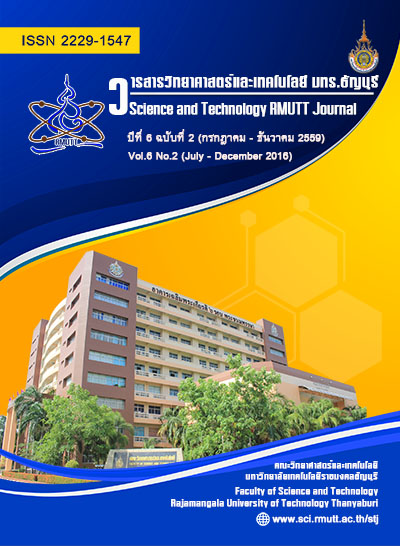Sub-acute Toxicity of Brown Rice Kefir Powder
Main Article Content
Abstract
The present study was designed to determine sub-acute toxicity of kefir powders from Khao Dawk Mali 105 (KDMLKP), Red Hawm (RHKP) and Hawm Nil (HNKP) brown rice. Kefir powders at the doses of 500, 1,000 and 2,000 mg/kg were given orally to the rats every 2 days for 14 days. The results showed that all the doses of the kefir powders did not produce mortality and any symptoms of toxicity. And also, kefir powders did not alter relative organ weight in the treated rats. Increasing KDMLKP significantly increased body weight gain in contrast to RHKP and HNKP. Kefir powders produced feed conversion ratio better than that PBS, but this did not KDMLKP at the doses of 500 and 1,000 mg/kg. Kefir powders at the doses of 1,000 and 2,000 mg/kg decreased blood sugar and affected renal and/or hepatic functions as KDMLKP significantly increased globulin, RHKP significantly decreased creatinine and uric acid but increased globulin, serum aspartate aminotransferase (AST), and serum alanine aminotransferase (ALT) and HNKP significantly decreased blood urea nitrogen, uric acid, and albumin but increased globulin, AST and ALT. Kefir powder also significantly decreased neutrophils, but increased lymphocytes.
These findings indicate that kefir powders at the dose of 500 mg/kg exert non sub-acute toxicity when the doses of 1,000 and 2,000 mg/kg administering every 2 days for 14 days decreased blood sugar and may cause renal and hepatic dysfunctions.
Article Details
References
L. Micheli, D. Uccelletti, C. Palleschi, V. Crescenzi. Isolation and characterization of a ropy Lactobacillus strain producing the xopolysaccharide quefiran. Applied Microbiol Biotechnol. 53 (1999): 69-74.
E. R. Farnworth. Kefir: from folklore to regulatory approval. J Nutraceut Funct & Med Foods. 1 (1999): 57-68.
H. Kesenkaş, N. Dinkçi, K. Seçkin, O. Kinik, S. Gönç. Antioxidant properties of kefir produced from different cow and soy milk mixtures. J Agri Sci. 17 (2011): 253-259.
S. Deeseenthum, J. Pejovic. Bacterial inhibition and antioxidant activity of kefir produced from Thai Jasmine rice milk. Biotechnol. 9 (2010): 332-337.
A. Moreno de LeBlanc, C. Matar, E. Farnworth, G. Perdigo´n. Study of immune cells involved in the antitumor effect of kefir in a murine breast cancer model. J Dairy Sci. 90 (2007): 1920-1928.
M.Y. Lee, K.S. Ahna, O.K. Kwon, M.J. Kim, M.K. Kim, I.Y. Lee, S.R. Oh, H.K. Lee. Anti-inflammatory and anti-allergic effects of kefir in a mouse asthma model. Immunobiol. 212 (2007): 647–654.
S. Hadisaputro, R.R.J. Djokomoeljanto, Judiono, M.E. Soesatyo. The effects of oral plain kefir supplementation on pro-inflammatory cytokine properties of the hyperglycemia Wistar rats induced by streptozotocin. Indonesian J Int Med. 44(2) (2012): 100-104.
G.R. Punaro, F.R. Maciel, A.M. Rodrigues, M.M. Rogero, C.S.B. Bogsan, M.N. Oliveira, S.S.M. Ihara, S.R.R. Araujo, T.R.C. Sanches, L.C. Andrade, E.M.S.Higa. Kefir administration reduced progression of renal injury in STZ-diabetic rats by lowering oxidative stress. Nitric Oxide. 37 (2014): 53–60.
O.K. Kwon, K.S. Ahn, M.Y. Lee, S.Y. Kim, B.Y. Park, M.K. Kim, I.Y. Lee, S.R. Oh, H.K. Lee. Inhibitory effect of kefiran on ovalbumin-induced lung inflammation in a murine model of asthma. Arch Pharm Res. 31 (2008): 1590-1596.
P.A. Bolla, P. Carasi, M.A. Bolla, G.L. Antoni, M.A. Serradell. Protective effect of a mixture of kefir isolated lactic acid bacteria and yeasts in a hamster model of Clostridium difficile infection. Anaerobe. 21 (2013): 28-33.
C.G.Vinderola, J. Duarte, D. Thangavel, G. Perdigon, E. Farnworth, C. Matar. Immunomodulating capacity of kefir. J Dairy Res. 72 (2005): 95–202.
A. Moongngarm, N. Saetung. Comparison of chemical compositions and bioactive compounds of germinated rough rice and brown rice. Food Chem. 122 (2010): 782-788.
A. Moongngarm, N. Daomukda, S. Khumpik. Chemical compositions, phytochemicals, and antioxidant capacity of rice bran, rice bran layer, and rice germ. APCBEE Procedia. 2 (2012): 73-79.
O. Selamassakul, N. Laohakunjit, O. Kerdchoechuen. Antioxidant activity of fermented brown rice by lactic acid bacteria. Agricultural Sci J. 44(2)(2013): 145-148.
S. Chunchom, S. Deeseenthum, T. Katisart, C. Talubmook. “Acute toxicity of brown rice kefir powder”. in International Conference Science and Technology (TICST). Pathum Thani, Thailand. 2015. 126-130.
Organisation of Economic Co-operation and Development (OECD), The OECD Guideline for Testing of Chemical: 407 Repeated Dose Oral Toxicity-Rodent: 28-Day or 14-Day Study, OECD, Paris, France, 2001.
S.K. Ramaiah. A toxicologist guide to the diagnostic interpretation of hepatic biochemical parameters. Food Chem Toxicol. 45 (2007): 1551–1557.


